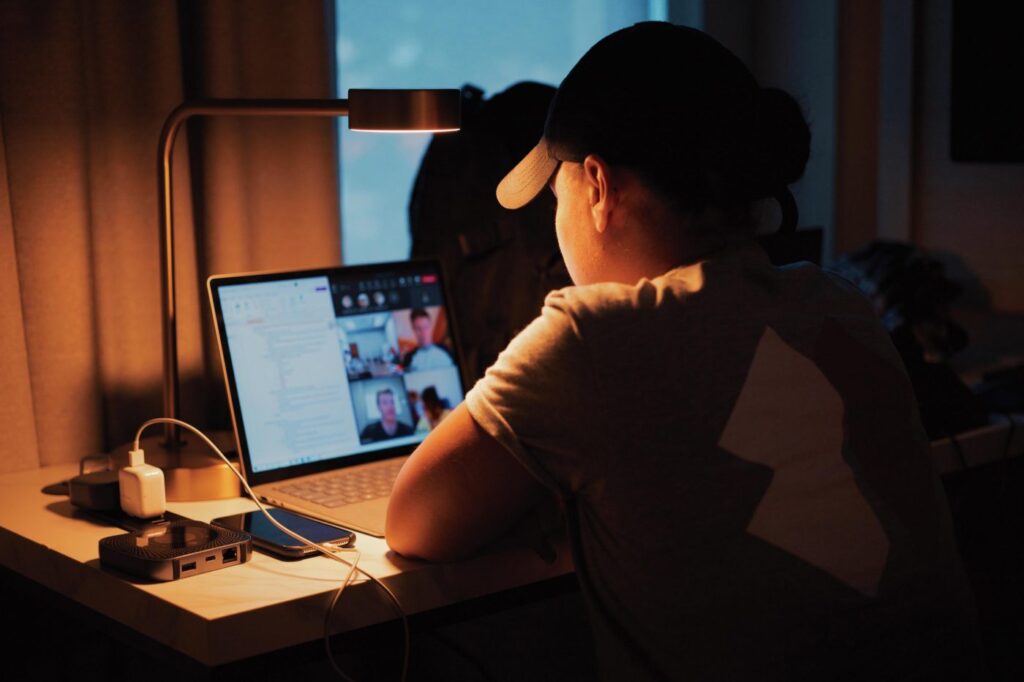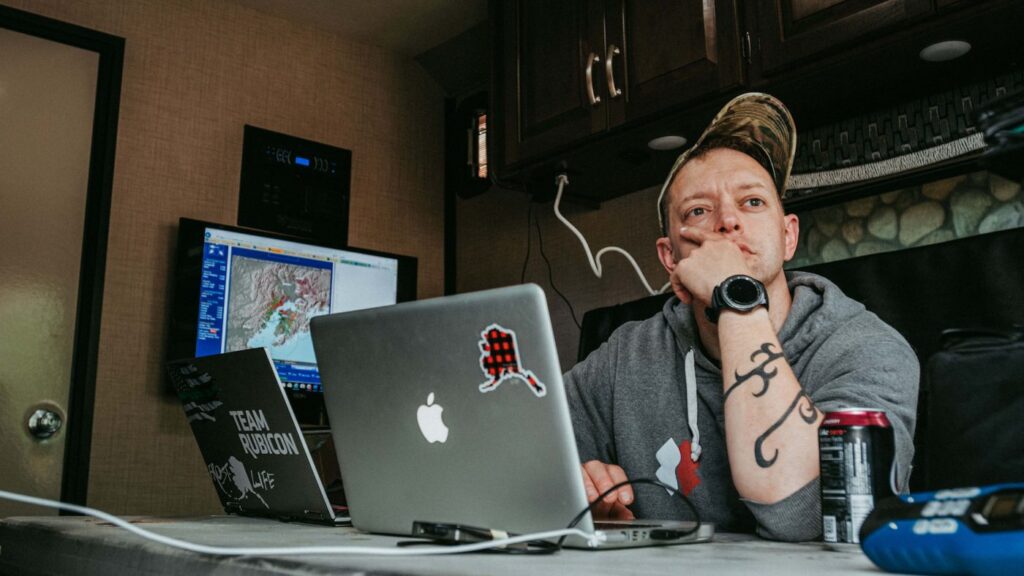Picture a disaster relief operation, and most people imagine teams of volunteers clearing tornado debris from homes and roadways, removing trees and branches strewn across roofs by a hurricane, or mucking out flooded homes. Yet, while all of those volunteer services are essential after any disaster, what many don’t realize is that behind every team of sawyers and heavy equipment operators are teams full of remote volunteers running maps and computers and making sure all that dirty work is able to get done.
In fact, for disaster response nonprofits like Team Rubicon, virtual volunteers can be the backbone of a successful response. Not only are they often the ones who parse satellite images and social feeds for precise info on damage, but they are typically also the ones who mobilize other Greyshirts to get into the field. In short, they are essential to getting disaster relief done.

Here are the teams with remote volunteer opportunities within Team Rubicon and a look at what each does.
Data, Intel, and Informed Responses: How the Situation Unit’s Virtual Volunteers Shape Relief
A ton of information is generated during a disaster, from intel collected from government reports and NGO coordination calls to data pulled from the National Business Emergency Operations Center to specifics gathered from FEMA situation reports—even on-the-ground truths collected by Team Rubicon’s own recon teams.
All of that information has to be turned into something of use, and it’s Team Rubicon’s Situation Unit that does that. And they use the intel gleaned to inform decision-makers on things like the scope and scale of the disaster, the duration of the immediate response, and when recovery can begin. The information gleaned by the Situation Unit isn’t proprietary: Team Rubicon also distributes its analysis to state and federal governments and other NGOs. Combining knowledge gained by Team Rubicon with that from other agencies and volunteer organizations with ground truths obtained from recon teams and even survivors on the ground not only improves understanding of the disaster at hand for all but also makes for more expeditious deployments and the ability to serve more people sooner.
The Situation Unit consists of five teams: Geographic Information Systems, Geospatial Visualization, Open-Source Collection, Social Media Collection, and Watch Center. Any Greyshirt interested in joining the Situation Unit can complete this form.
The Geographic Information Systems Team: Mapping Impact
During a disaster, Team Rubicon uses geographic information systems, or GIS, to map everything from the demographic makeup and social vulnerability index in the projected path of a hurricane to the route of destruction left by a tornado to what disaster-affected areas are without power or water—and more. The GIS team may even scour FEMA’s ArcGIS site or relevant story maps to answer essential questions about disaster impacts. And they use their GIS skills to geospatially display information for Team Rubicon decision-makers as well as for the public.
“GIS allows us to identify communities most in need by analyzing risks and damages and vulnerable populations,” says Team Rubicon’s Senior Associate in charge of Operations Support, Francesca Williams.
Anyone with the general cartography skills needed to build and produce maps—and especially those with previous experience working with GIS, and preferably ESRI ArcGIS—can volunteer to help the GIS team create informative maps to describe impacted areas, identify unmet needs in a community, map out Forward Operating Bases, logistics centers, and more.
The Geospatial Visualization Team: Stalking Satellite Intel
While the GIS team is all about maps, remote volunteers on the geospatial visualization—or GeoViz—team are all about that thing that’s worth a thousand words: pictures.
During a disaster, the GeoViz team analyzes satellite images and other overhead imagery from both pre- and post-disaster to better understand the impacts of the storm, identify ingress and egress routes, and even to drill down on what kind of equipment might be needed for route clearance or recovery efforts. The information this team gathers helps inform Team Rubicon on the overall severity of the disaster, as well as helps identify the largest schools within or near the disaster zone that Team Rubicon can use for a Forward Operating Base and whether TR can establish a Mobile Command Center in a parking lot.
To serve on the GeoViz team, Greyshirts need to be experts with prior working experience in the fields of Geospatial Intelligence (GEOINT) and Imagery Intelligence (IMINT).
The Open-Source Collection Team: Scourers of Internet Info
There’s never one authoritative source for all information on a disaster. Rather, rumors, facts, and even live reports flow across a range of sources, including websites, government sites, the Global Disaster Alert and Coordination System, the news media, situation reports produced by other organizations, news software such as Factal, and more.
Team members collect all of this open-source data and then feed it to an open-source analyst who parses whether there’s damage, how extensive the damage is, and more, and turns that analysis into actionable intel.
While no prior experience is necessary to volunteer on the Open-Source Collection team, volunteers must be able to adapt quickly to shifting priorities and landscapes and be proactive in gathering reliable information from outside of the provided resources.
The Social Media Collection Team: #MaximizingAction
In the Information Age, when everyone has a cell phone that they use to capture and share their daily lives with people across the globe, social media is becoming one of disaster relief’s best tools. That’s because, within a disaster zone, those affected often document—in real time—what has happened to them, their neighbors, and their communities.
For disaster relief organizations, some of the best sources of truth after a disaster often come from reviewing social media posts. From Facebook posts to tweets to even SnapMap, these social shares can inform disaster responders on the severity of the disaster, locations of unmet needs, and areas that are already saturated with assistance.
During a disaster, the volunteers on the social team scour through all channels of social media—including but not limited to Facebook and Facebook groups, TikTok, Instagram, Snapchat, and X, formerly known as Twitter—and utilizes resources such as Factal to identify potentially valuable information, which they pass along to an analyst for further vetting.
The Watch Center Team: Keepers of the Early Warning System
Watch Center is the early warning system for Team Rubicon, the team that searches the globe for potential hazards and disaster impacts on a daily basis, so Team Rubicon is always at the ready.
Early each morning, volunteers across the country compile weather data and news from around the country and the globe for a daily report on potential disaster events. That intel is collated into Team Rubicon’s daily hazard brief, which is sent out every weekday and apprises recipients of disasters and potential humanitarian events Team Rubicon is monitoring and may respond to.
While no special skills are needed to serve on the Watch Center team, volunteers (sign up here) need to be available weekdays in the early morning hours, typically between 7:30 and 9:30 a.m. Eastern time.

Less Mapping, More Ways to Get Support Done
Not all remote volunteer opportunities require a deep knowledge of mapping, social media, or news and weather monitoring skills. Sometimes during an operation it’s remote volunteers who are essential to getting ops stood up and getting Greyshirts into the field.
Emergency Operations Center Support Team Opportunities
When large-scale disasters occur, a centralized command-and-control post is set up to facilitate operations. Known as an Emergency Operations Center, the EOC integrates all disaster management functions and provides strategic guidance for all elements of the response. Volunteers are crucial to an EOC and especially to assuring the quality and accuracy of relevant information. And they play a role in supporting a variety of teams, including Logistics, Mobilization, Planning, Field Tech, Brandcomms, and even Finance. For virtual volunteer opportunities within EOC, contact NationalPlanning@teamrubiconusa.org.
Remote Volunteer Opportunities for Getting Greyshirts into the Field: Mobilization
Among the volunteer leaders most used remotely during a disaster are mobilization leaders: the people who put Greyshirts into disaster zones.
“Mobilization leaders make sure Greyshirts get to where they need to be,” says Team Rubicon Mobilization Manager Brent Slough, “so that impacted communities receive the right personnel.” Mob leaders are frequently the point of contact for deploying Greyshirts, answering questions about availability and travel timelines.
To join the mobilization team, visit the leader positions job board from within Roll Call.
Finance Section Chief Remote Volunteer Opportunities
From finance to logistics to planning, section chiefs are some of the most in-demand volunteer leaders within Team Rubicon. But it’s during a disaster that one specific type of section chief is especially utilized remotely: finance section chiefs.
“Finance section chiefs are part of the Command and General staff for a Team Rubicon operation,” says Senior Finance Associate Sharilyn Wasser, “and integral to the bigger picture.” During a disaster, remote finance section chiefs help finance an operation, ensuring that funds are available to purchase everything from food and water for the FOB to gas to get Greyshirt teams into the field to spare parts to repair a chain on a saw.
To serve as a finance section chief, Greyshirts need to take and pass the Finance Section Chief training in Roll Call, after which they’ll be invited to a call with a Branch Finance Lead before onboarding.

Whether you’re looking for a chance to get into the field or a way to support from home, Team Rubicon has in-person and virtual volunteer opportunities for everyone. Those not yet a Team Rubicon can start by signing up to become a Greyshirt. Greyshirts looking to step up their impact can apply for leadership and remote volunteer roles within Roll Call or can email NationalPlanning@teamrubiconusa.org.



